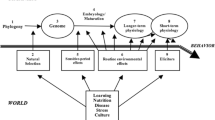Abstract
Molecular explanations of behavior, based on momentary events and variables that can be measured each time an event occurs, can be contrasted with molar explanations, based on aggregates of events and variables that can be measured only over substantial periods of time. Molecular analyses cannot suffice for quantitative accounts of behavior, because the historical variables that determine behavior are inevitably molar. When molecular explanations are attempted, they always depend on hypothetical constructs that stand as surrogates for molar environmental variables. These constructs allow no quantitative predictions when they are vague, and when they are made precise, they become superfluous, because they can be replaced with molar measures. In contrast to molecular accounts of phenomena like higher responding on ratio schedules than interval schedules and free-operant avoidance, molar accounts tend to be simple and straightforward. Molar theory incorporates the notion that behavior produces consequences that in turn affect the behavior, the notion that behavior and environment together constitute a feedback system. A feedback function specifies the dependence of consequences on behavior, thereby describing properties of the environment. Feedback functions can be derived for simple schedules, complex schedules, and natural resources. A complete theory of behavior requires describing the environment’s feedback functions and the organism’s functional relations. Molar thinking, both in the laboratory and in the field, can allow quantitative prediction, the mark of a mature science.
Similar content being viewed by others
References
Anger, D. (1963). The role of temporal discriminations in the reinforcement of Sidman avoidance behavior. Journal of the Experimental Analysis of Behavior, 6, 477–506.
Baum, W. M. (1973). The correlation-based law of effect. Journal of the Experimental Analysis of Behavior, 20, 137–153.
Baum, W. M. (1981). Optimization and the matching law as accounts of instrumental behavior. Journal of the Experimental Analysis of Behavior, 36, 387–403.
Baum, W. M. (1986). Performance on ratio and interval schedules: Some data and some theory. Invited address at the convention of the Association for Behavior Analysis, Milwaukee.
Baum, W. M. (1987). Random and systematic foraging, experimental studies of depletion, and schedules of reinforcement. In A. C. Kamil, J. R. Krebs, & H. R. Pulliam (Eds.), Foraging behavior (pp. 587–607). New York: Plenum Press.
Herrnstein, R. J. (1969). Method and theory in the study of avoidance. Psychological Review, 76, 49–69.
Herrnstein, R. J., & Hineline, P. N. (1966). Negative reinforcement as shock-frequency reduction. Journal of the Experimental Analysis of Behavior, 9, 421–430.
Killeen, P. (1968). On the measurement of reinforcement frequency in the study of preference. Journal of the Experimental A nalysis of Behavior, 11, 263–269.
Mazur, J. E. (1986). Learning and behavior. Englewood Cliffs, NJ: Prentice-Hall.
Rachlin, H. (1976). Behavior and learning. San Francisco: Freeman.
Solomon, R. L., & Wynne, L. C. (1954). Traumatic avoidance learning: The principles of anxiety conservation and partial irreversibility. Psychological Review, 61, 353–385.
Staddon, J. E. R. (1973). On the notion of cause, with applications to behaviorism. Behaviorism, 1, 25–63.
Staddon, J. E. R. (1980). Optimality analyses of operant behavior and their relation to optimal foraging. In J. E. R. Staddon (Ed.), Limits to action (pp. 101–141). New York: Academic Press.
Stephens, D. W., & Krebs, J. R. (1986). Foraging theory. Princeton: Princeton University Press.
Taylor, R. J. (1984). Predation. New York: Chapman and Hall.
Author information
Authors and Affiliations
Rights and permissions
About this article
Cite this article
Baum, W.M. Quantitative Prediction and Molar Description of the Environment. BEHAV ANALYST 12, 167–176 (1989). https://doi.org/10.1007/BF03392493
Published:
Issue Date:
DOI: https://doi.org/10.1007/BF03392493



